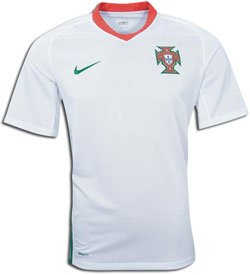Nike Portugal Away Jersey-football white/pine green
 The authentic 2008 Portugal Players Jersey
The authentic 2008 Portugal Players JerseyCard manufacturers were producing trading cards long before the Dallas Cowboys joined the NFL in 1960. In the 1950's Topps began packaging their signature product, bubblegum, with baseball and football cards. From there, as football grew in popularity, players could find their likeness on items such as milk cartons, soft drink caps, cereal boxes and plastic cups. The emergence of the AFL in 1960 allowed Topps competitors, beginning with Fleer, to make inroads in the business. The 1961 Fleer set featured both leagues, and then they focused on the AFL alone. Philadelphia Gum secured the NFL rights for 1964, forcing Topps to go for the AFL which left Fleer with no product in either baseball or football. Philadelphia Gum produced football card sets featuring Cowboys from 1964 through 1967. In 1982 Topps was licensed by NFL Properties for the first time. Previously, team logos on helmets were removed by airbrush. In the 70's Fleer rejoined the ranks by producing sets of cards called Fleer Team Action and FTA Stickers. They focused on NFL teams not individual players and were able to use team logos. The "card explosion" started around 1989 with new companies joining the fold like Pro Set and Score. By 1992 there were more than 30 brands of football cards. It was a new era for the hobby. You could all but forget about collecting all the cards of your favorite team, but now focus on a favorite player or two. Just to put it all in perspective - with all the parallel, inserts, and variations - in 1995 there were over 250 different cards produced of Troy Aikman.
The Cowboys were an expansion team in 1960. Their first roster was created by choosing 36 players from the 12 existing franchises (three per team). In the first set of cards featuring Dallas Cowboys players, 1960 Topps, all the players were pictured in the uniforms of the teams they departed. The next year they took part in the NFL draft and acquired Bob Lilly with their first ever draft pick. There have been many outstanding players through the years that have donned the blue star on their helmet, several of which are members of the Pro Football Hall of Fame. Only one man held the position of head coach for the first 29 years of the organization - Tom Landry. Coach Landry led the Cowboys to two Super Bowl titles, five NFC Championships, 13 NFC East titles, 18 trips to the playoffs and 20 winning seasons.
There were no plastic holders or sleeves to keep your cards from harms way in the early years. They were rubber banded together and tossed in shoe boxes and the stickers were stuck onto school notebooks or bike fenders. Cards were flipped and traded with your buddies and even thumb tacked or taped on bulletin boards. All these things lend to the value of the cards today. If you were lucky enough to have kept very good care of your cards when you were younger, and your mother didn't toss that shoebox in the attic out with the trash, you could already have a good start to your collection. Now with all the top-loaders, sorting boxes, screw downs and nine-slot binder pages available to the collector, it's much easier to take care of those gems. That is why I consider 1960 - 1990 the vintage years. Those older cards can sometimes be very difficult to find in great condition. That is not to say that the cards manufactured after 1990 have no value or collectible appeal. They just won't be as scarce or hard to find in great condition twenty or even fifty years from now. I encourage you to collect beyond 1990 and on. It's a whole new hobby now with more resources to fill your checklists like the internet and card shows.
The Dallas Cowboys Complete Football Card Guide - Vol 3
A beautifully illustrated 226 page, full-color guide, provides the Dallas Cowboy collector with information on over 6000 different sets from 1960 to 2006.

